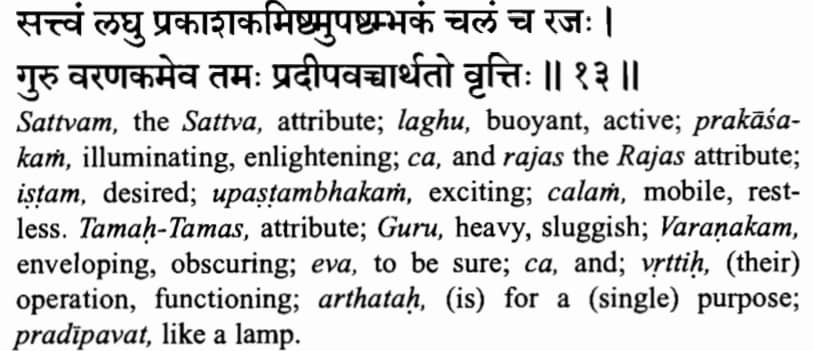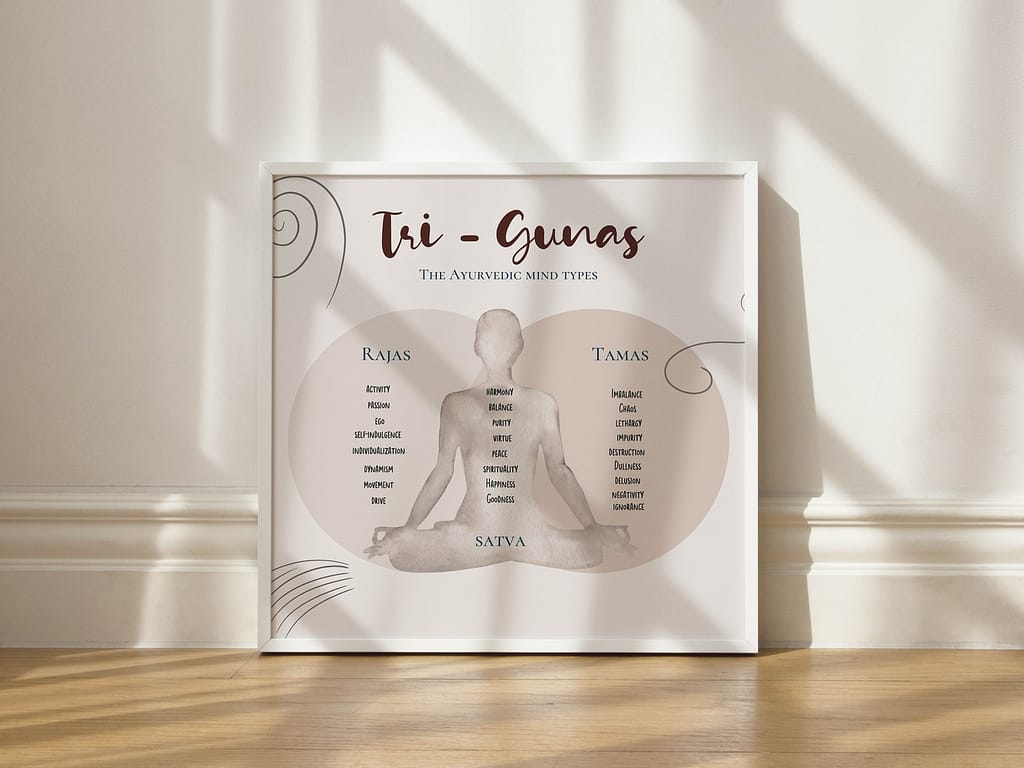Sattva, Rajas and Tamas are the three gunas and the most important and basic energy concept of the Yogic culture. Its uses and implementations can also be seen in Ayurveda. It helps us understand the energy systems of human body and mind and how specific foods, diet and habits can be used to keep the body, mind and consciousness in balance.
These three gunas or universal qualities govern all creation. They are the fundamental forces of nature. According to the text shamkyakarika (shamkhya is an ancient school of thought describing the reality of existence and creation. It is the theory of metaphysics), the satva guna is buoyant and illuminating, rajas is exciting, mobile and restless and tamas is heavy, sluggish and obscuring.

Sattva is almost a complete opposite of tamas. Sattva and tamas are both inactive in nature while rajas the mobile and drives the other two to move and have effect. The combination of the three in different variations creates different objects.
Sattva -> Light, Buoyant, Illuminating
Rajas -> Exciting, Mobile, Restless
Tamas -> Enveloping, Heavy, Sluggish, Inertia

Ayurvedic Perspective
Ayurveda considers the three gunas to have an immense effect on physical and phycological system. Ayurveda divides all food types as well as herbs in sattvic, rajasic and tamasic types.
Sattvic food is considered the purest form of food for the body. Consuming this food group makes the body feel light and calms the mind. It constitutes of foods that are clean, fresh and brimming with high pranic energy (the life force). Sattvic foods are life enhancing and health creating. It promotes happiness, intelligence, mental clarity and peacefulness.
List Of Sattvic Foods
Amaranth, Millet, Barley, buckwheat, Quinoa, Maize, Bulgur, Quinoa, Whole wheat, jowar, bajra, ragi, brown rice, high quality rice like basmati, oats. In general all whole grains.
All beans and legumes which are light in color. Mung dal is considered very pranic and sattvic.
All types of fresh green vegetables, herbs and spices, cold pressed plant based oils, ghee, milk, home made paneer and cheese, honey and sweet tasting fruits.
Fresh ginger, coriander, cardamom , fennel, turmeric.
Unsalted nuts and seeds like pine nuts, flax seeds, sesame seeds, pumpkin seeds, soaked almonds, walnuts, coconut, dates, fig.
List Of Rajasic Food
Rajasic foods are those that stimulate the body and make it move due to the mobile nature of rajas guna. It overstimulates the body and mind and builds stress, anger, and suppressed feelings. It also gives birth to excessive competitiveness, selfishness and aggressiveness. A buildup of stress can be a result of consuming rajasic foods.
Rajasic food can be beneficial as it can improve decision making and can create an environment of ‘making things happen’ as it is the energy of movement.
Pungent vegetables, starchy vegetables like potato, broccoli, cabbage, cauliflower, eggplant, onion and garlic, radishes, hot peppers, tomato, sea weed.
Eggs, fermented foods like yogurt, very spicy foods, sugar, coffee, tea, carbonated drinks, ice creams, tobacco. Other nervous stimulants like msg, asafetida, tobacco (cigarettes etc.), overly sweet or salty foods / junk food.
Also contains chocolate, dark lentils, sour and salty foods.
List Of Tamasic Food
Food brimming with tamas guna makes the body and mind heavy and lethargic. It creates inertia and inactivity. It dulls the senses and makes the body inflexible, heavy and attached to the physical and material things.
Meat, Chicken, Fish, Pork, Beef and other non vegetarian foods, Mushrooms, alcohol, recreational drugs, refined grains, over ripe fruits, preservatives found mixed in foods, canned and frozen food, artificial sweeteners, old and stale food.
It also contains fried foods, frozen or microwaved foods, packaged foods, Margarine, pasteurized, homogenized / powdered milk.
List Of Ayurvedic Herbs That Are Considered Sattvic
- Amla,
- Tulasi,
- Ginger,
- Ashwagandha,
- Sesame,
- Shatavari,
- Gokshura,
- Saffron,
- Turmeric,
- Neem,
- Black pepper,
- Haritaki,
- Pippali,
- Jatamansi,
- White Sandalwood,
- Licorice,
- Shankhapushpi,
- Brahmi,
- Gotu Kola,
- Punarnava,
- Cinnamon,
- Vacha,
- Coriander,
- Cumin
Yogic Relevance Of Trigunas
Yoga is an act of taking an individual from the tamasic and rajasic energy to pure sattvic energy. It aims at removing inertia and excessive restlessness and increasing the sattvic energy in the body to bring it to a state of calm, and equilibrium.
When one is in sattva, he is flowing with creative and pure energy. In Yogic tradition, a spiritual seeker is encouraged to bring sattvic energy in the system to reach higher states of consciousness.
If you like this article, Pin this image to your Pinterest Ayurveda boards


Ayurveda and yoga advocates the balance of all three, not just sattvic foods. As Brahma said, “one cannot exist without the other”. Don’t post false information.
Hi Karan,
Thanks for your input. Please elaborate so I can correct the information in the article. Please give a little bit of brief so that the reader can get also get additional information.
Regards,
Swati